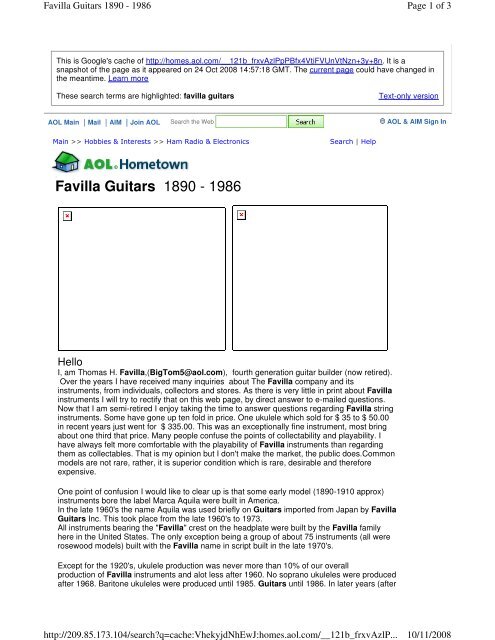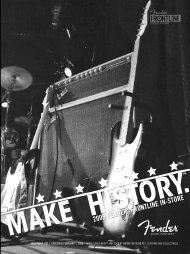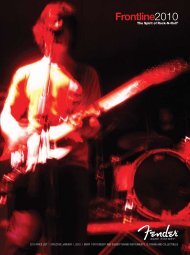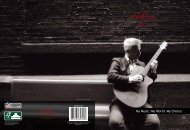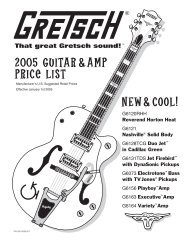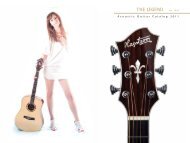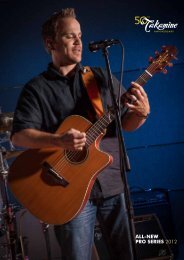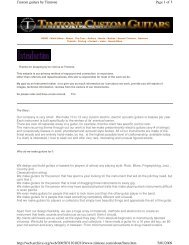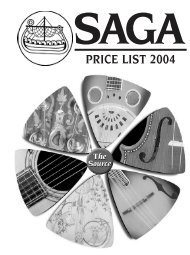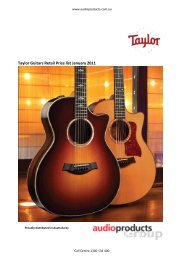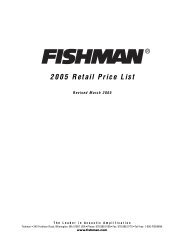The definitive Favilla Guitar History. - Jedistar
The definitive Favilla Guitar History. - Jedistar
The definitive Favilla Guitar History. - Jedistar
Create successful ePaper yourself
Turn your PDF publications into a flip-book with our unique Google optimized e-Paper software.
<strong>Favilla</strong> <strong>Guitar</strong>s 1890 - 1986<br />
http://209.85.173.104/search?q=cache:VhekyjdNhEwJ:homes.aol.com/__121b_frxvAzlP...<br />
Page 1 of 3<br />
10/11/2008<br />
This is Google's cache of http://homes.aol.com/__121b_frxvAzlPpPBfx4VtiFVUnVtNzn+3y+8n. It is a<br />
snapshot of the page as it appeared on 24 Oct 2008 14:57:18 GMT. <strong>The</strong> current page could have changed in<br />
the meantime. Learn more<br />
<strong>The</strong>se search terms are highlighted: favilla guitars<br />
Text-only version<br />
AOL Main Mail AIM Join AOL Search the Web<br />
AOL & AIM Sign In<br />
Main >> Hobbies & Interests >> Ham Radio & Electronics<br />
Search | Help<br />
<strong>Favilla</strong> <strong>Guitar</strong>s 1890 - 1986<br />
Hello<br />
I, am Thomas H. <strong>Favilla</strong>,(BigTom5@aol.com), fourth generation guitar builder (now retired).<br />
Over the years I have received many inquiries about <strong>The</strong> <strong>Favilla</strong> company and its<br />
instruments, from individuals, collectors and stores. As there is very little in print about <strong>Favilla</strong><br />
instruments I will try to rectify that on this web page, by direct answer to e-mailed questions.<br />
Now that I am semi-retired I enjoy taking the time to answer questions regarding <strong>Favilla</strong> string<br />
instruments. Some have gone up ten fold in price. One ukulele which sold for $ 35 to $ 50.00<br />
in recent years just went for $ 335.00. This was an exceptionally fine instrument, most bring<br />
about one third that price. Many people confuse the points of collectability and playability. I<br />
have always felt more comfortable with the playability of <strong>Favilla</strong> instruments than regarding<br />
them as collectables. That is my opinion but I don't make the market, the public does.Common<br />
models are not rare, rather, it is superior condition which is rare, desirable and therefore<br />
expensive.<br />
One point of confusion I would like to clear up is that some early model (1890-1910 approx)<br />
instruments bore the label Marca Aquila were built in America.<br />
In the late 1960's the name Aquila was used briefly on <strong>Guitar</strong>s imported from Japan by <strong>Favilla</strong><br />
<strong>Guitar</strong>s Inc. This took place from the late 1960's to 1973.<br />
All instruments bearing the "<strong>Favilla</strong>" crest on the headplate were built by the <strong>Favilla</strong> family<br />
here in the United States. <strong>The</strong> only exception being a group of about 75 instruments (all were<br />
rosewood models) built with the <strong>Favilla</strong> name in script built in the late 1970's.<br />
Except for the 1920's, ukulele production was never more than 10% of our overall<br />
production of <strong>Favilla</strong> instruments and alot less after 1960. No soprano ukuleles were produced<br />
after 1968. Baritone ukuleles were produced until 1985. <strong>Guitar</strong>s until 1986. In later years (after
<strong>Favilla</strong> <strong>Guitar</strong>s 1890 - 1986<br />
http://209.85.173.104/search?q=cache:VhekyjdNhEwJ:homes.aol.com/__121b_frxvAzlP...<br />
Page 2 of 3<br />
10/11/2008<br />
1945) our instruments followed a rather basic model number pattern. Classic guitars started<br />
with the letter "C" and steel string with "F". <strong>The</strong>n came the model number, generally 5,6,or 8.<br />
Custom models were numbers 9 and 10 (never more then 12 built in any given year). A<br />
special model was the 12 string guitar, model F12H, about 60 per year were built from 1962 to<br />
1973. <strong>The</strong> "H" designation after the model number was for the dreadnaught body size, actually<br />
alittle fuller than that represented by the Martin D series. Its six string companion was the<br />
popular model F-8H which rated equal to the Martin D-18.<br />
<strong>The</strong> Company<br />
<strong>The</strong> earliest record of the <strong>Favilla</strong>'s dates to the 1800's when three brothers Francesco,<br />
Antonio and Jacamo,fled France to what is now Italy. Jacamo a priest and violin maker who<br />
trained in Cremona Italy, taught Francesco violin making. It is from that Francesco, who had a<br />
son named Francesco, who was the father of Giovanni (John) and Joseph that the instrument<br />
making arm of the family in the United States is decended.<br />
Joseph and John (my grandfather) started building in the United States in 1890. Four years<br />
later formed a company in 1894 which was the forerunner of <strong>Favilla</strong> <strong>Guitar</strong>s.<br />
<strong>The</strong>re has been some confusion among collectors, some of who think there was as many as<br />
three <strong>Favilla</strong> companies. Actually the main company is decended from John (Giovanni) and<br />
his brother Joseph. Along with them worked a number of brothers, sisters and cousins. One<br />
cousin Anthony formed a company about 1926 that was in business for about 3 years and<br />
produced some banjo's and ukulele's. Some further confusion results from my grandfather<br />
John sometimes using his middle name Nicholas and his brother Joseph using his middle<br />
name, Edward. Some people think they were seperate builders, this was not the case. My<br />
father Hercules (Herk) <strong>Favilla</strong> was actively building on and off from 1935 to 1980.<br />
In July 1963 Frank <strong>Favilla</strong>, (one of Johns two sons) who had split with his brother (Herk)<br />
formed a company "Villar" which was in business for nine months until Franks death in 1964.<br />
John and Joseph started building in the United States In 1890, By 1894 they had a music store<br />
at 200 Grand street and across the street an instrument shop at 201 Grand street in New York<br />
City. In the early 1920's,the shop moved to 161 Bowery where they employed 55 people,<br />
building thousands of ukuleles,as well as mandolins, banjos, guitars and some violins (built by<br />
Joseph). If it had strings on it the <strong>Favilla</strong> brothers built it. About 1930 they moved the shop<br />
briefly to 552 Myrtle avenue in Brooklyn, NY, then to 4W.16th Street in New York City Where<br />
the shop remained until 1959 when it was taken over by my father Hercules (known as Herk)<br />
after a tumultous ten year internal struggle with his brother Frank (a brilliant builder but not a<br />
businessman). In 1959, Herk received full control from the family and changed the name to<br />
<strong>Favilla</strong> <strong>Guitar</strong>s Inc, He quickly moved the shop to larger quarters at 57 Front Street Brooklyn,<br />
where he remained until 1963. I joined the firm full time in 1962 (I had been working after<br />
school and in the summers for my grandfather since 1957). In late 1963 Herk made a major<br />
move to 60 Smith street in E.Farmingdale, Long Island, quadrupling the size of the shop.<br />
Production hit a peak of about 3,500 guitars a year. <strong>The</strong>n by 1967 the rapid rise in popularity<br />
of the electric guitar financially strapped the company and it had to retrench. Not having the<br />
financial backing to produce an electric guitar line in volume, the company began to downsize.<br />
By 1973 commercial production ceased. In 1975, I opened a guitar retail store, in Huntington,<br />
NY, my father and I built a few custom guitars a year until 1980 when Herk retired. I<br />
continued building a few guitars a year until 1985 when other business matters took up more<br />
of my time. In January 1986 I sold the retail operation and ceased all building.<br />
It is a fact that the <strong>Favilla</strong>'s where the original developer of the Baritone Ukulele in the 1940's it<br />
was a reguler part of their line by 1948 and Herk <strong>Favilla</strong> Published the first Baritone Ululele<br />
Method in 1949.
<strong>Favilla</strong> <strong>Guitar</strong>s 1890 - 1986<br />
http://209.85.173.104/search?q=cache:VhekyjdNhEwJ:homes.aol.com/__121b_frxvAzlP...<br />
Page 3 of 3<br />
10/11/2008<br />
For an excellent photo array visit Carls Ukulele Community on the Link below<br />
(Updated August 11, 2008)<br />
My Favorite Links<br />
Ukulele Diner<br />
Uke-Yak<br />
Carls Ukulele Community Photo Album<br />
Download AIM<br />
AIM Remote<br />
Send me an<br />
Instant<br />
Message<br />
Add me to<br />
Your Buddy<br />
List<br />
Join my Chat<br />
Room<br />
Download AOL Instant Messenger<br />
Send me an<br />
Email<br />
Add<br />
Remote<br />
to<br />
page created with Easy Designer


